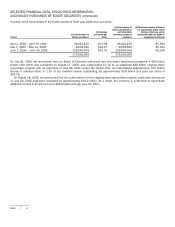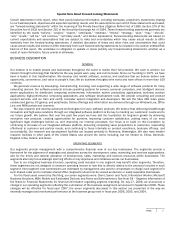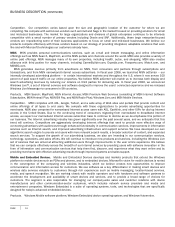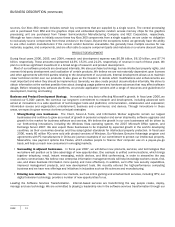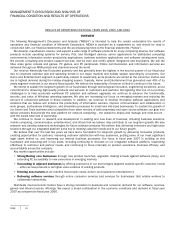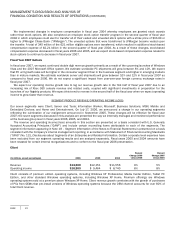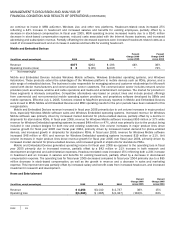Microsoft 2006 Annual Report Download - page 17
Download and view the complete annual report
Please find page 17 of the 2006 Microsoft annual report below. You can navigate through the pages in the report by either clicking on the pages listed below, or by using the keyword search tool below to find specific information within the annual report.
PAGE 16
BUSINESS DESCRIPTION (CONTINUED)
We may not be able to protect our source code from copying if there is an unauthorized disclosure of source code. Source
code, the detailed program commands for our operating systems and other software programs, is critical to our business. While
we license certain portions of our source code for various software programs and operating systems to a number of licensees,
we take significant measures to protect the secrecy of large portions of our source code. If an unauthorized disclosure of a
significant portion of our source code occurs, we could potentially lose future trade secret protection for that source code. The
loss of future trade secret protection could make it easier for third parties to compete with our products by copying functionality,
which could adversely affect our revenue and operating margins. Unauthorized disclosure of source code could also increase
certain risks described in the next paragraph.
Security vulnerabilities in our products could lead to reduced revenues or to liability claims. Maintaining the security of
computers and computer networks is a critical issue for us and our customers. Hackers develop and deploy viruses, worms, and
other malicious software programs that attack our products. While this is an industry-wide problem that affects computers
across all platforms, it affects our products in particular because hackers tend to focus their efforts on the most popular
operating systems and programs and we expect them to continue to do so. We devote significant resources to address these
critical issues. We focus on engineering even more secure products, enhancing security and reliability options and settings
when we deliver products, and providing guidance to help our customers make the best use of our products and services to
protect against computer viruses and other attacks on their computing environment. In addition, we are working to improve the
deployment of software updates to address security vulnerabilities discovered after our products are released. We are also
investing in mitigation technologies that help to secure customers from attacks even when such software updates are not
deployed. We advise customers on how to help protect themselves from security threats through the use of our online
automated security tools, our published security guidance, and the deployment of security software such as firewalls, anti-virus,
and other security software. The cost of these steps could reduce our operating margins. Despite these efforts, actual or
perceived security vulnerabilities in our products could lead some customers to seek to return products, to reduce or delay
future purchases, or to use competing products. Customers may also increase their expenditures on protecting their existing
computer systems from attack, which could delay adoption of new technologies. Any of these actions by customers could
adversely affect our revenue. In addition, actual or perceived vulnerabilities may lead to claims against us. While our license
agreements typically contain provisions that eliminate or limit our exposure to such liability, there is no assurance these
provisions will be held effective under applicable laws and judicial decisions.
We are subject to government litigation and regulatory activity that affects how we design and market our products. As a
leading global software maker we receive scrutiny from government agencies under U.S. and foreign competition laws. Some
jurisdictions also provide private rights of action for competitors or consumers based on alleged anti-competitive conduct. For
example, we have been involved in the following actions.
Lawsuits brought by the U.S. Department of Justice, 18 states, and the District of Columbia in two separate actions were
resolved through a Consent Decree that took effect in November 2001 and a Final Judgment entered in November 2002. These
proceedings imposed regulatory constraints on our Windows operating system businesses, including limits on certain
contracting practices, required disclosure of certain software program interfaces, limits on Microsoft’s ability to ensure the
visibility of certain Windows features in new PCs, and required licensing of certain communications protocols. While we believe
we currently are in full compliance with the Decree and Judgment, if we fail to comply with them in the future additional
restrictions could be imposed on us that would adversely affect our business.
In March 2004, the European Commission determined that we must create new versions of Windows that do not include
certain multimedia technologies, many of which are required for certain Web sites, software applications and other aspects of
Windows to function properly, and we must provide our competitors with specifications for how to implement certain
communications protocols supported in Windows. Microsoft has appealed both determinations to European courts. As a result
of the Commission decision, we have incurred and will (absent a reversal of this ruling) continue to incur duplicative
development costs. The Commission ruling obligates Microsoft to make available specifications for certain Windows
communications protocol technologies on licensing terms that are closely regulated by the Commission. The availability of these
licenses may enable competitors to develop software products that better mimic the functionality of Microsoft’s own products
which could result in a reduction in sales of our products. Pending resolution of Microsoft’s appeal, there will remain uncertainty
about the legal principles that govern product design issues for future releases of Microsoft products in Europe. These
uncertainties could cause Microsoft to modify product design and delay release dates for Windows or other products.


